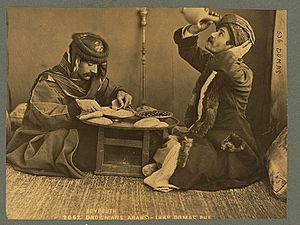Briq facts for kids
A Briq, also called Ibrik or Brik (Arabic: برق), is a very old type of teapot and pitcher. People in Lebanon and Syria have traditionally used it to make and drink tea or water. It's a special pot with a handle and a unique spout. This design makes it easy to drink directly from the Briq without needing a separate cup. It also helps mix tea well. Briqs were usually made from earthenware (clay), but you can also find glass ones. Learn more about how a Briq works!
Contents
What is a Briq?
A Briq is more than just a pot; it's a clever invention from ancient times. Its special shape allows you to pour and drink liquids easily. Imagine a small pitcher with a long, narrow spout that curves just right. This design means you don't need a cup, making it very convenient for people on the go.
Briq Materials
Most Briqs were traditionally made from earthenware. This is a type of pottery made from clay, which is then baked to make it hard. Earthenware Briqs are strong and keep liquids cool. Today, you might also see Briqs made from glass, which gives them a different look.
How People Use a Briq
In the past, people often carried their Briqs with them. This was a simple way to stay hydrated and quench their thirst wherever they went. The Briq's design made it very practical and easy to use, especially when traveling.
Sharing Tea and Water
Sharing tea with friends and guests is a big part of the culture in Lebanon and Syria. It was common to offer tea from a Briq as a friendly gesture, even to people you were doing business with. One important thing about drinking from a Briq is that your lips do not touch the spout. This makes it very hygienic, especially when several people share the same Briq.
The Long History of the Briq
The Briq has a very long history, going back thousands of years. We know that people in Lebanon were using Briqs between 1050 and 850 BC. This was during the time of the Phoenician civilization, an ancient people known for their trade and seafaring.
Briqs from the Bronze Age
Even older Briqs have been found, some dating back to the Early Bronze Age (around 3500-2200 BC). These very old Briqs didn't have handles like the ones we see today. It's not clear if people used them for drinking water in the same way they do now. However, these discoveries show that the idea of a special drinking vessel has been around for a very long time.
Briqs Today
Even though modern cups and bottles are common now, drinking from a Briq is still practiced in some rural villages in Lebanon, like Sawfar. Many Lebanese people also keep Briqs as special cultural items. They might display them on a shelf or even use them as flower vases. While their everyday use has decreased, there are efforts today to bring back this ancient tradition and celebrate it as an important part of Lebanese heritage.


